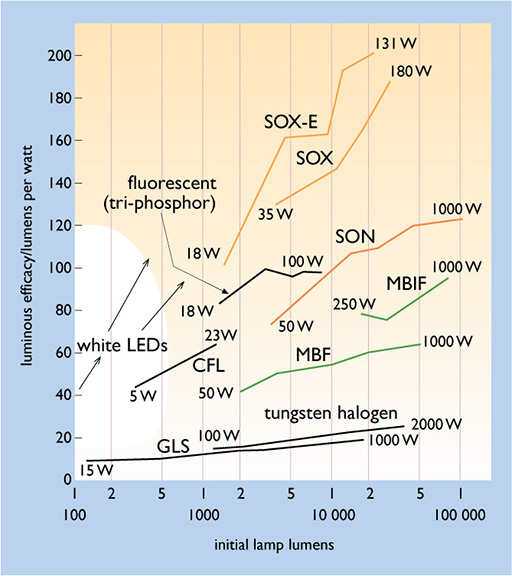4.2.1 Lamp types
Although traditional incandescent electric light bulbs (also known as ‘General Lighting Service’ or GLS lamps) have been sold by wattage as ‘60 watt’ or ‘100 watt’ lamps, what actually counts is the amount of light they produce. This is measured in units of lumens (lm). For example a 100 watt GLS lamp produces about 1200 lumens. Modern lamp packaging now clearly states the light output allowing a clear comparison between the wide range of lamp technologies now on sale.
Table 12 gives a brief summary of different types of lamps. The sale of conventional incandescent and many types of halogen lamps is now being phased out almost worldwide, since they can be conveniently replaced with lower energy LED and compact fluorescent alternatives.
| Lamp type | Details |
|---|---|
| General lighting service (GLS) | The traditional incandescent light bulb |
| Tungsten halogen | Miniature incandescent lamps. Substitutes for conventional GLS lamps use minature halogen bulbs inside a GLS-sized casing |
| Fluorescent high-pressure mercury discharge lamp (MBF) | Bluish white light, often used for shop lighting |
| Metal halide high-pressure mercury discharge lamp (MBIF) | Bluish white light, used for street lighting |
| Compact fluorescent lamp (CFL) | Replacement for normal incandescent light bulbs |
| Tri-phosphor tubular fluorescent | Standard type for office and shop lighting |
| High-pressure sodium discharge lamp (SON) | Orange-white light, used for street lighting |
| Low-pressure sodium discharge lamp (SOX) and higher-efficacy version (SOX-E) | Pure orange light, used for street lighting |
| Light-emitting diode (LED) | Available in white and a range of colours Replacement for normal incandescent light bulbs and now widely used for street lighting |
An important factor in choosing a lamp is its luminous efficacy , the amount of light emitted in lumens per watt of electricity used (lumens W-1). This figure is also likely to be found on modern lamp packaging. Another important factor is the colour rendering index (CRI), which measures how well the light from a lamp imitates the broad spectrum of white light from the sun. GLS and tungsten halogen lamps have very good colour rendering while that from orange sodium street lamps is very poor.
Figure 42 shows the efficacies of the different lamp types listed in Table 12 and how, for a given type, the efficacy increases with power.
Very high efficacies are available for street lighting, but most domestic applications require lamps of under 1000 lumens output. Until the appearance of CFLs in the 1980s there were no high-efficacy low-powered lamps, yet this is where most domestic lighting applications lie. There was a large gap at the left side of Figure 42 that needed filling by new technologies. For domestic use the ‘standard’ light bulb (for over 70 years) has been the 800 lumen 60 watt GLS incandescent lamp. Its attractions were its familiarity and its good colour rendering, yet it only had an efficacy of 13 lumens W−1.
Its rivals, the compact fluorescent lamp (CFL) and new white LED lamps are considerably more efficient and have a longer life expectancy but do not have the same quality of colour rendering. LED lamps give full brightness when switched on unlike CFLs which may take several minutes to warm up. The sale of conventional GLS incandescent lamps has largely been phased out in Europe and many other countries as an energy efficiency measure. Small halogen incandescent lamps remain on sale. These are 30% more efficient than GLS lamps and have a good colour rendering index. However the sale of even these is currently (2023) being phased out, since they can be replaced with LEDs.

